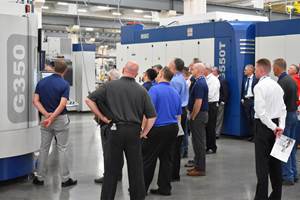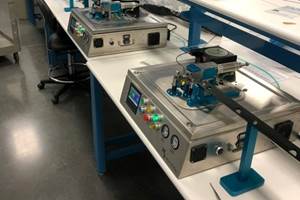Software/Tooling Partnership Promises Easier HSM
High-efficiency parameters are calculated automatically—partly using a slider that lets the programmer set the level of aggressiveness.
Share




Iscar industry projects specialist Tom Raun says he has often helped shops adopt high speed machining techniques by standing over the programmer’s shoulder during his visit to a shop.
“It works when you do this...,” he might say.
Formerly a tool-and-die programmer himself, he once did exactly the kind of programming work in Mastercam—facing exactly the same kinds of machining and workpiece challenges—as many of his customers today. Unfortunately, though, having support personnel like Mr. Raun give in-person coaching is not a scalable strategy for helping shops get the most from their tooling.
A new partnership between Iscar and Mastercam promises to be much further-reaching.
Beginning with the new version X5 of Mastercam, the software’s high speed machining capabilities will now draw upon detailed cutting tool performance data from Iscar. When the software’s “Dynamic Mill” tool paths are used, the programmer can choose from a library of Iscar tools designed for high speed machining, and input just the conventional speed and feed rate information for these tools. From there, the software automatically finds the right parameters for a much more effective machining process—one in which the new parameters might be very different.
“High efficiency machining” is actually the term both companies prefer. That’s because the cutting speed itself is not the main driver of faster metal removal. Rather, the more significant factor is the feed rate increase that becomes possible when the tool path controls tool engagement, and also takes advantage of the radial chip thinning that results from a light radial depth of cut.
Radial chip thinning permits feed rates that can be dramatically higher than what a shop might expect, Mr. Raun says. When the effect of chip thinning is combined with a high spindle speed, a programmed feed rate well over 500 ipm might be possible in a material that had traditionally been milled much more slowly. Various programmers have told him they had avoided such feeds, because they assumed the recommendations citing them must have been in error.
Still other shops have tried to take advantage of chip thinning using feed rate override at the CNC. This is problematic, he says, because the optimal use of chip thinning involves tailoring the speed and feed rate together—something feed rate override can’t do.
The Mastercam software simplifies the use of these seemingly counterintuitive milling parameters. Test data from Iscar’s own extensive cutting trials form the basis of the software’s capability. When high efficiency machining is employed using an Iscar tool, the programmer just selects a radial stepover level, choosing 5, 7 or 10 percent of tool diameter. Then, no other parameter related to higher efficiency has to be known—because the rest of the interface is a slider bar that controls the math involved in getting the parameters right. With this bar, the programmer essentially finds the level of aggressiveness that the shop prefers for its own high-efficiency cutting.
Mastercam sales manager Steve Bertrand explains. He says the programmer starts with standard cutter-use parameters, including feed-per-tooth for the workpiece material. The programmer then varies the slider bar according to his or her own sense of the rigidity of the setup and the rigidity and accuracy of the machine—factors the software cannot anticipate. Based on this input, the software calculates a new speed and feed rate, using formulas aimed at optimizing throughput and tool life. Because spindle speed is not essential to the results, the shop can see benefits on both its high speed and non-high-speed machines.
“The real benefit is that shops now have somewhere to go,” Mr. Bertrand says. The capability helps the large number of shops that do have a machining process able to achieve faster metal removal, if only the right high-efficiency parameters could be found. With the new software that integrates Iscar’s and Mastercam’s insights into an easy interface, meeting this challenge is now just a matter of edging the slider a little further up the scale.
Related Content
Grob Systems Inc. to Host Tech Event With Industry Partners
The 5-Axis Live technology event will highlight new machining strategies for optimizing the production of complex medical, aerospace and mold/die parts.
Read MoreIn Moldmaking, Mantle Process Addresses Lead Time and Talent Pool
A new process delivered through what looks like a standard machining center promises to streamline machining of injection mold cores and cavities and even answer the declining availability of toolmakers.
Read MoreLyndex-Nikken Collets Enable Accurate Small-Diameter Cutting
The MMC Mini-Mini collet chuck is well suited for high-speed machining applications where clearance is needed, such as die mold, aerospace and medical parts.
Read MoreFor This Machine Shop, Licensing Is the Answer to the Inventor’s Dilemma
Machine shops are natural inventors, but not necessarily suited to supporting and marketing a product. This Minnesota shop with an invention related to micromolding will share it through licensing.
Read MoreRead Next
Registration Now Open for the Precision Machining Technology Show (PMTS) 2025
The precision machining industry’s premier event returns to Cleveland, OH, April 1-3.
Read MoreSetting Up the Building Blocks for a Digital Factory
Woodward Inc. spent over a year developing an API to connect machines to its digital factory. Caron Engineering’s MiConnect has cut most of this process while also granting the shop greater access to machine information.
Read MoreBuilding Out a Foundation for Student Machinists
Autodesk and Haas have teamed up to produce an introductory course for students that covers the basics of CAD, CAM and CNC while providing them with a portfolio part.
Read More

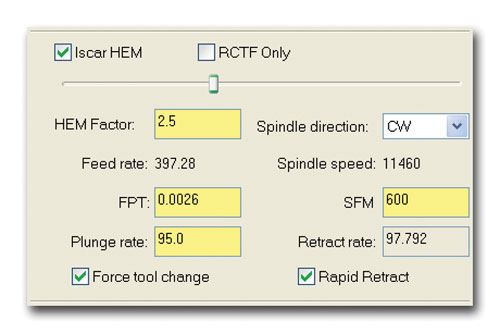
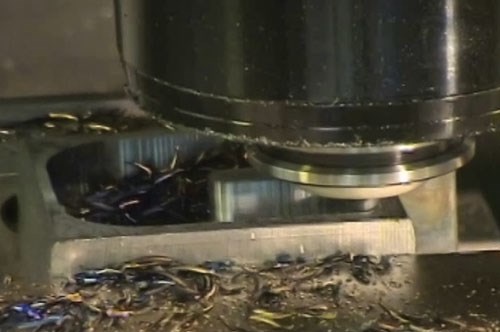
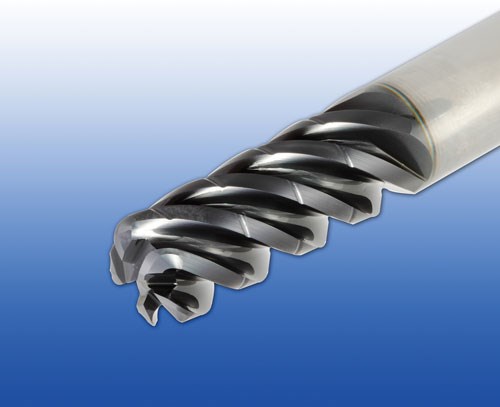




















.jpg;maxWidth=300;quality=90)


